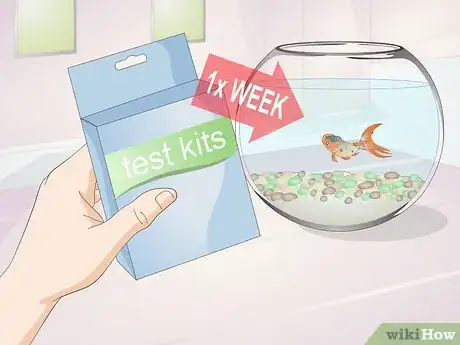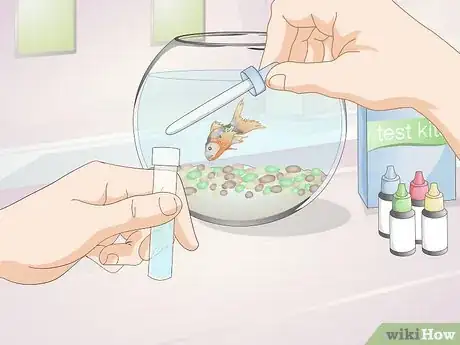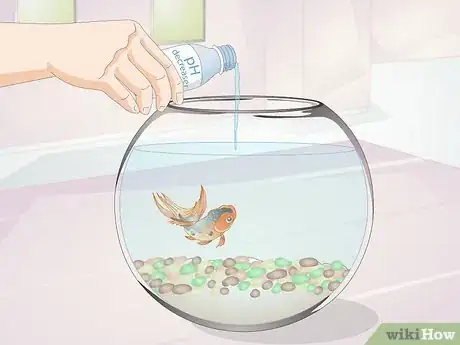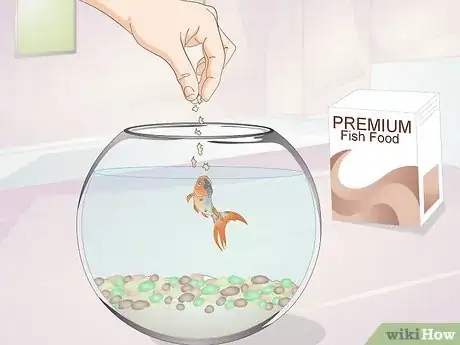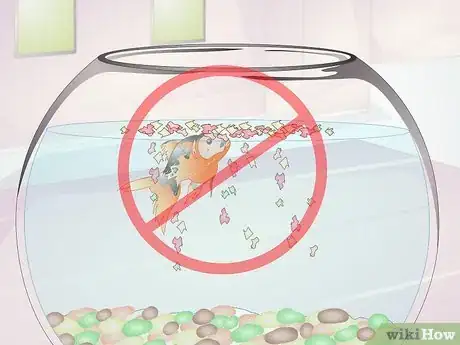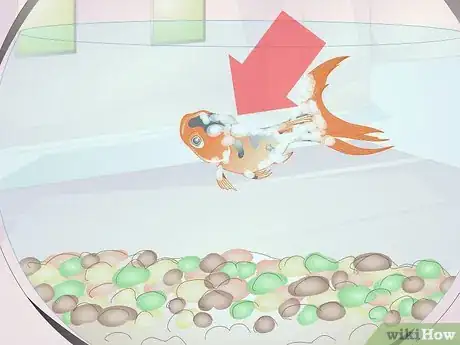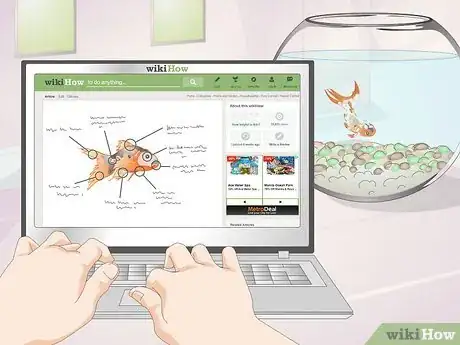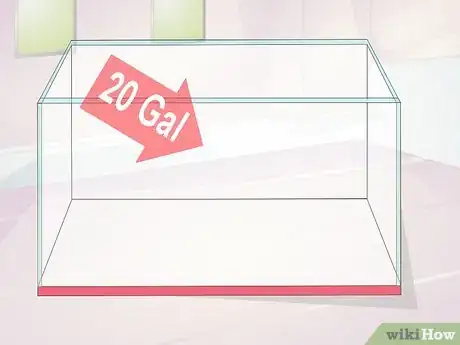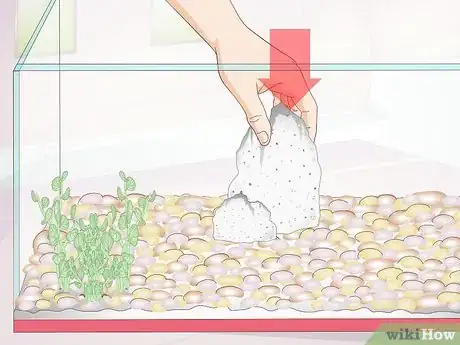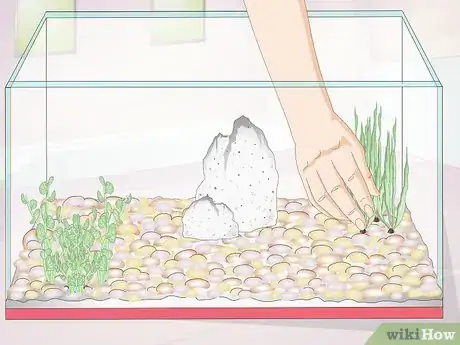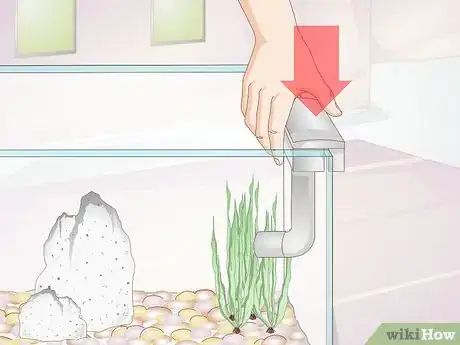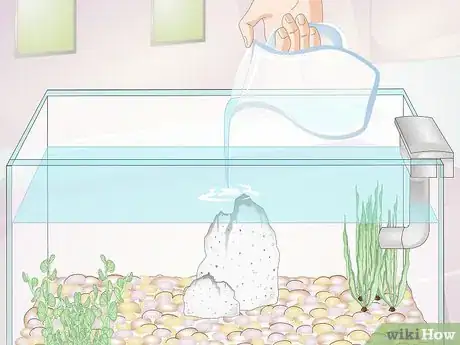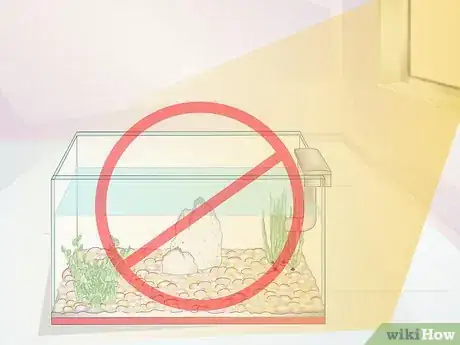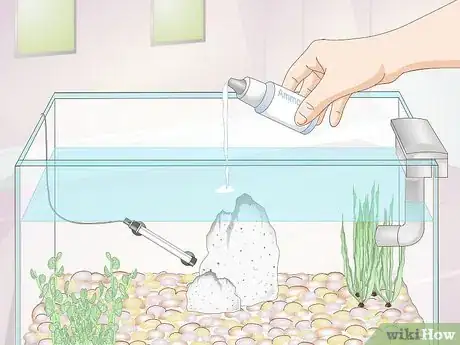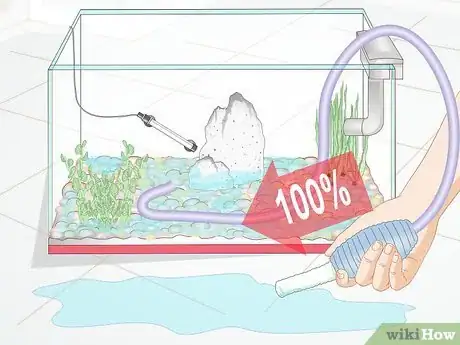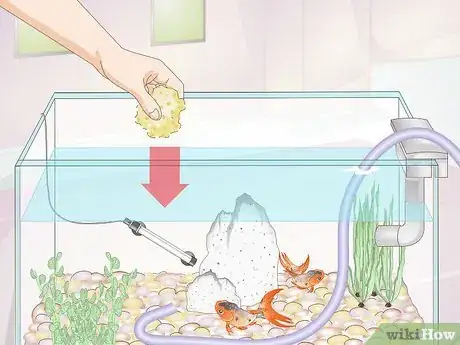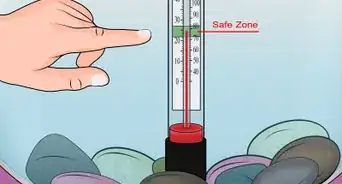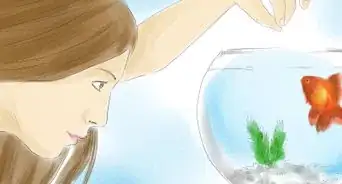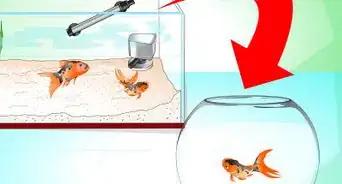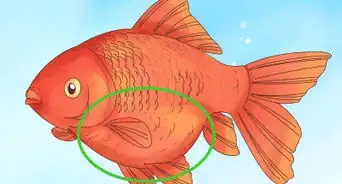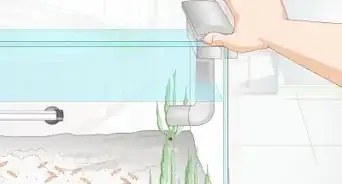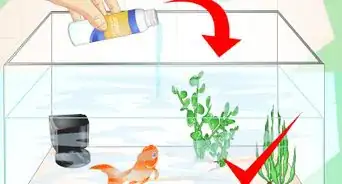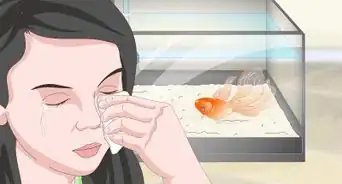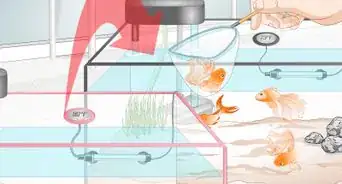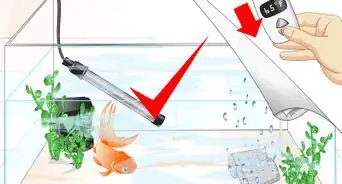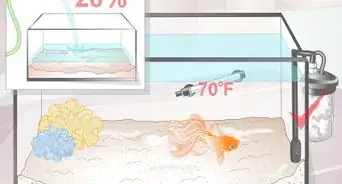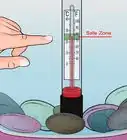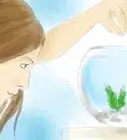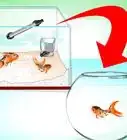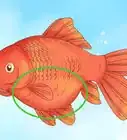This article was co-authored by Craig Morton. Craig Morton is the CEO of Aquarium Doctor Inc. based in Huntington Beach California and servicing Orange County, Los Angeles County, and the Inland Empire. With over 30 years of aquarium experience, Craig specializes in creating custom aquarium designs along with aquarium installation, service, and maintenance.
There are 8 references cited in this article, which can be found at the bottom of the page.
This article has been viewed 104,627 times.
One of the most important factors in maintaining your goldfish’s health is the quality and condition of the water in its tank. Ensure that your tank is properly set up and that water quality is actively maintained. Further, watch out for common signs of goldfish illnesses and feed your goldfish appropriately to ensure it stays alive.
Steps
Testing Weekly for Water Quality
-
1Test your goldfish’s water weekly. Get a fish tank water-testing kit from the pet store, which should include testing equipment for reading ammonia, nitrite, nitrate, and pH levels.[1] Several natural processes that occur in your tank can be kept in check by setting up your tank properly, but certain parameters still need to be tested for every week.
-
2Keep ammonia levels at 0ppm. Ammonia is a natural byproduct of the food your goldfish doesn’t eat, as well as the goldfish’s waste. Bacteria will eat the ammonia in your tank, but if the bacteria die or something else goes wrong, high ammonia levels can become extremely dangerous.[2]
- If you’re getting positive ammonia readings, change the tank’s water immediately.
- Determine whether overfeeding, an insufficient filtering system, or overcrowding and remedy the issue as soon as possible.
Advertisement -
3Maintain nitrite levels at 0ppm and nitrate levels below 40ppm. Nitrites are usually converted by your water filter into nitrates, but can make your goldfish unhealthy if not kept in check. During cycling, nitrite levels may reach 0.75ppm, but should never exceed this amount. Keep nitrate levels between 5 and 20ppm.[3]
- Change the tanks water if nitrites are present. Their presence indicates ammonia levels are likely also too high, or your filtration system needs to be adjusted.
- Nitrate, which is safe at low levels, can also be harmful at higher levels and can lead to unwanted algae in the tank.
- A partial water change should be sufficient to reduce nitrate levels.
-
4Ensure a pH-balanced tank. Water that is too acidic will allow ammonia levels to increase very quickly. Water that is too alkaline (or basic) actually makes natural levels of ammonia more harmful.[4]
- Shoot for the ideal levels of pH for goldfish, which are between 7.2 and 7.6 pH.
- If you need to adjust pH, do so minimally by adding pH decreaser or alkaline buffers that are designed for this purpose, and are available online or in pet stores.
- Use water generated by reverse osmosis if you are unable to change the pH of the water you're using. You may be unable to adjust the pH of certain municipal water supplies because of specific mineral content in the water.
Feeding and Caring for your Goldfish
-
1Feed your goldfish a well-monitored, nutritious diet. Feed your goldfish 2 or 3 times a day. Feed them only a few pinches of food each session. Be sure you’re feeding your goldfish nutritional feed that is designed for the particular type of goldfish you have.[5]
- In total, provide an amount of food over the course of the day that allows for 5 to 6 minutes of feeding.
- If the food is dry, soak it in water from the tank for five to ten seconds before feeding your fish. Un-soaked food can injure or sicken the fish when it expands in the stomach.
- Favor pellets, which should sink, but also include flaked fish food – which will often float on the surface, as goldfish like to eat from both the surface and the bottom of the tank.
-
2Take care not to overfeed your goldfish. While feeding goldfish, follow the classic "less is more" approach, as overfeeding a goldfish leads to far more dangerous complications than underfeeding. Watch for long trails of poop trailing from behind your goldfish. If present, you're feeding it too much.[6]
-
3Watch out for signs of illness or infection. Your goldfish should usually be fully aware of its surroundings and be moving around with interest and excitement. Most of a goldfish’s time is spent nibbling on stuff and actively swimming around. If your goldfish isn’t doing so, look closely for signs that it may be sick.[7]
- Goldfish eyes should be entirely clear. If your goldfish has foggy eyes, it is likely sick.
- Check out the fish’s fins and body. Fins should be stiff and solid, without uneven edges.
- Look at the goldfish’s skin. White spots, fuzzy patches, or red streaks all indicate illness.
- Test your water at the first signs of illness. Often, an illness is a sign that either water or feeding needs to be adjusted.
-
4Diagnose your goldfish’s illness by consulting specific symptom lists online. Whether your goldfish has developed unsightly spots, is floating around erratically, or has fins that are not as sprightly as usual, there are proven methods of treatment for the most common goldfish illnesses.[8]
- There a handful of common goldfish diseases, most of which can be treated by refreshing the water, though some require more detailed treatment.
- Identify the particular sickness your goldfish is suffering from by crosschecking its symptoms with online descriptions and treat your fish accordingly.
- Check out the various wikiHow articles on how to treat common goldfish health issues such as swim bladder complications and white spots.
Providing Your Goldfish a Healthy Living Space
-
1Choose an appropriate container to house your goldfish. Though many goldfish are doomed to life inside a glass sphere, fishbowls are generally not spacious enough for a goldfish to be happy and healthy. A 20 gallon (75.7 L) is ideal for your first goldfish, as it can hold 2-3 fancy goldfish if you decide to increases your fish forces.
- The type of goldfish you have will help determine the size of tank they’ll need. Fancy goldfish can be kept in a 10 gallon (37.9 L) tank, but bigger goldfish like comets need a tank of around 50 gallons (189.3 L).
- For each additional goldfish you add to your aquatic family, increase the capacity of your fish tank by roughly 10 gallon (37.9 L) for each additional fish.
-
2Cover the bottom of the tank with appropriately sized gravel. Gravel is necessary to help maintain the water quality of your tank and to keep your goldfish happy. Goldfish are scavengers. They will pick up pieces of gravel and toss them back and forth, or just gum them for a while with their fish lips. Accordingly, choose gravel that is made up of individual pieces that are too large for the fish to swallow.
-
3Decorate your goldfish’s domain. Further, goldfish are curious, and benefit from incredibly short memories. Provide your goldfish up with ample rocks, caves, or artificial plants. A well-decorated tank can provide them with a lifetime of adventure. Your selection of décor, including natural or artificial rocks and plants must follow the following guidelines:
- Don’t use wood. Though that piece of driftwood from your beach walk does look spectacular, it will likely discolor your fish tank’s water and may even turn to mush.
- Beware of materials that may affect the pH of the water. If you’re adding stuff you find outside, even just rocks and sea-shells, check your pH frequently.
- Don’t place anything sharp in your fish tank. If your goldfish becomes frightened and move quickly, they may injure themselves.
-
4Only put certain natural plants in your goldfish tank. Goldfish are notoriously aggressive with plants. While gravel can defend itself, plants will easily get torn up by the voracious behavior of your goldfish friends. Some plants are more resilient, and tend to get along better with goldfish generally.
- Gravel and natural plants in particular provide more than an inviting ambiance – they also help keep the biological environment inside the tank stable, so include at least a few natural plants in your tank.
- Try Vallisneria types, different Hygrophilas, Red Bacopa or even Ludwigia Arcuata.
Filling and Placing Your Fish Tank Safely
-
1Use a filtration system. A filter is a vital piece of equipment to help keep your goldfish alive.[9] The filter you’ll need depends on the size of your tank, as filters operate according to a flow rate which will correspond with the amount of water your tank holds. Ensure you get a filter with the correct flow rate, and choose between an external or internal filter.[10]
- If you can’t match your tank’s capacity to a the exact flow rated filter, go overboard. For instance, if you have a 20 gallon (75.7 L) tank, shoot for a filter rated for 40 gallons (151.4 L).
- External filters sit on an outside wall of the tank or within the tank’s lid. Internal filters are submerged within the tank. Either type of filter can work for a goldfish tank.
- Lean towards opting for an external filter, as they have a greater capacity to store filtration materials, can clean water more thoroughly, and will require less maintenance.
-
2Add safe, clean, and balanced water. Your goldfish requires properly conditioned water to neutralize commonly occurring chlorine and chloramine. Feel free to use tap water, for instance, but add conditioner from a pet supplies store to make it safe for your goldfish to live in.[11]
- Make sure the water has the right pH level too. For goldfish, ideal pH levels are a slightly alkaline 7.2-7.6 pH.
- Use a pH test kit to test your goldfish’s water regularly, and adjust the pH if necessary with additives available at the pet store.
-
3Place the goldfish’s tank somewhere safe and sensible. Do not place the tank near a window or any heating or cooling source. Do not allow sunlight to hit the tank directly. Also be sure the tank is set on something flat and extremely sturdy.[12]
- Though you will likely need to set your fish tank near an outlet, don’t allow electrical cords dangle over your fish tank. An electrical shock could absolutely fry your goldfish, and be dangerous for you as well.
- Similarly, be sure that no cord is pulling against the side of the tank or the base that the tank is resting upon. Place the tank in a location it will not be jostled.
-
4Make sure the water temperature stays between 60 °F (16 °C) and 72 °F (22 °C).[13] You probably don’t need a heater to maintain a temperature in this range, as it almost identical to the range commonly maintained in human dwellings. If you live in a particularly hot or cold climate, ensure that seasonal or daily changes in temperature do not put your goldfish at risk.
Cycling Your Fish Tank’s Water
-
1Grow healthy bacteria in your tank by adding ammonia. Before moving your goldfish into its tank, let the water sit for at least a few weeks. This time is necessary for the tank to provide a healthy biological environment for your goldfish, so be patient![14] More specifically, allow the tank to build colonies of bacteria, which will develop on the filter and in the gravel. You’ll maintain this biological environment via a process called cycling.
- Once your tank is setup and the filter is installed and turned on, add ammonia.
- Continue adding ammonia – while trying to keep it’s amount at 0.06ppm – until enough bacteria have developed to eat both the ammonia and nitrites in your tank.
- Determine your levels of ammonia, nitrites, and nitrates by using test kits designed for this purpose.
- Continue the process until you get readings that indicate zero ammonia and zero nitrite.
-
2Cycle the fish tank’s water once a month. Regularly cycle the fish tank by changing 100% of the tank’s water while taking care to keep the bacteria that are present in the tank alive. This will help your water “cycle” nitrogen, which is necessary to keep your fish alive.[15]
- After the emptying the tank of water, add fresh, conditioned water.
- Repeat the process of adding ammonia and testing for ammonia, nitrites, and nitrates.
- Once you have reading of zero ammonia and zero nitrite, as well as a bit of nitrate in the water - which is produced by the bacteria - your tank has been successfully cycled.
-
3Speed up the cycling process with a few tricks. Keep the water slightly warmer during cycling to increase the speed of bacteria growth. You can even borrow bacteria from a friend who already has a well-established, recently cycled fish tank. Seed your own tank by taking some of their gravel or cutting off a piece of their filter’s sponge and adding it to your tank.[16]
- Alternatively, add a bottle of ready-to-go bacteria from the fish store. If you go this route, still expect to add some ammonia and test until the tank is balanced.
-
4Change some of the tank’s water at least every other week. You need to change the water even more often than you cycle it. To curb the buildup of waste, change 25% of the tank’s water at least every other week.[17] Leave some of the water in the tank, however, to maintain a healthy amount of bacteria developed by less frequent cycling.
- When changing some of the tank’s water, rinse the filter and any tank décor with water your remove from the tank.
- Never use tap water to rinse anything that goes in your tank.
- Only add clean water that you’ve treated with conditioner.
Expert Q&A
-
QuestionHow can I keep a goldfish alive in a bowl?
 Craig MortonCraig Morton is the CEO of Aquarium Doctor Inc. based in Huntington Beach California and servicing Orange County, Los Angeles County, and the Inland Empire. With over 30 years of aquarium experience, Craig specializes in creating custom aquarium designs along with aquarium installation, service, and maintenance.
Craig MortonCraig Morton is the CEO of Aquarium Doctor Inc. based in Huntington Beach California and servicing Orange County, Los Angeles County, and the Inland Empire. With over 30 years of aquarium experience, Craig specializes in creating custom aquarium designs along with aquarium installation, service, and maintenance.
Aquarium Specialist, Aquarium Doctor Inc. The most important thing is to use reverse osmosis filtered water in the bowl.
The most important thing is to use reverse osmosis filtered water in the bowl. -
QuestionI have 1 goldfish, 2 angel fish, and 2 red tail shark, but one goldfish and one angel fish died. What could be the reason?
 CaeiiaTop AnswererThey don't go together. Goldfish are cold water and angelfish and the shark are tropical. The shark can be aggressive.
CaeiiaTop AnswererThey don't go together. Goldfish are cold water and angelfish and the shark are tropical. The shark can be aggressive. -
QuestionWhy might the fish not eat the food?
 Community AnswerThere are lots of reasons a fish might not be eating. The most likely is simply that they are not hungry, so be sure you're not overfeeding. Further, look for any other signs of illness. If nothing is up, switch the type of fish food you're using. For instance, switch to pellets if you're only using flakes, or vice versa.
Community AnswerThere are lots of reasons a fish might not be eating. The most likely is simply that they are not hungry, so be sure you're not overfeeding. Further, look for any other signs of illness. If nothing is up, switch the type of fish food you're using. For instance, switch to pellets if you're only using flakes, or vice versa.
References
- ↑ http://thegoldfishtank.com/goldfish-care/tank/goldfish-tank-setup-water/
- ↑ http://thegoldfishtank.com/goldfish-care/tank/goldfish-tank-setup-water/
- ↑ http://thegoldfishtank.com/goldfish-care/tank/goldfish-tank-setup-water/
- ↑ http://www.drsfostersmith.com/pic/article.cfm?articleid=1320
- ↑ http://thegoldfishtank.com/goldfish-food/what-do-goldfish-eat/
- ↑ http://thegoldfishtank.com/goldfish-food/what-do-goldfish-eat/
- ↑ http://www.kokosgoldfish.com/tensteps.html
- ↑ http://thegoldfishtank.com/goldfish-diseases/
- ↑ Craig Morton. Fish & Aquarium Specialist. Expert Interview. 21 July 2020.
- ↑ http://thegoldfishtank.com/goldfish-care/kit/do-goldfish-need-a-filter/
- ↑ http://thegoldfishtank.com/goldfish-care/tank/goldfish-tank-setup-water/
- ↑ http://www.goldfish-as-pets.com/tank_set-up.html
- ↑ http://www.goldfish-as-pets.com/tank_set-up.html
- ↑ http://thegoldfishtank.com/goldfish-care/tank/goldfish-tank-setup-water/
- ↑ http://thegoldfishtank.com/goldfish-care/tank/goldfish-tank-setup-water/
- ↑ http://thegoldfishtank.com/goldfish-care/tank/goldfish-tank-setup-water/
- ↑ Craig Morton. Fish & Aquarium Specialist. Expert Interview. 21 July 2020.
About This Article
To keep a goldfish alive, keep it in a tank that can hold at least 10 gallons of water so it has plenty of space to swim around. Additionally, use a filter that’s rated for your tank size in order to keep the water clean. Along with a healthy living space, make sure to feed your goldfish no more than what it can eat in 2 to 3 minutes per feeding to avoid dangerous health complications. You should also check the water once a week using a water-testing kit from your local pet store to ensure that it’s clean and balanced. For more advice from our Veterinary co-author, including how to keep a goldfish alive by cycling its tank water, keep reading!
